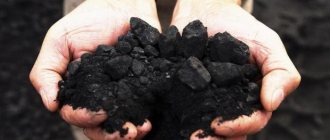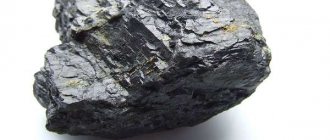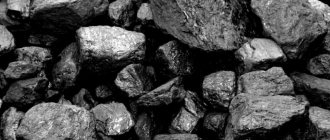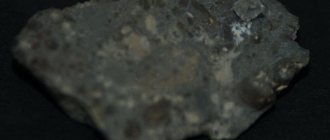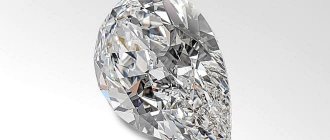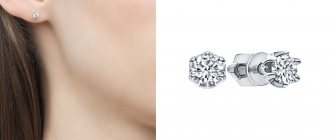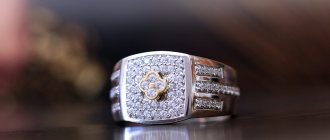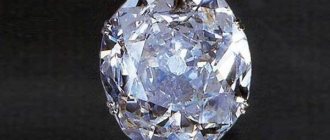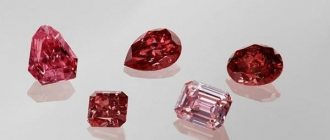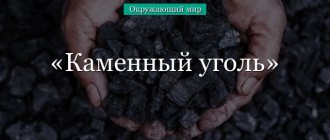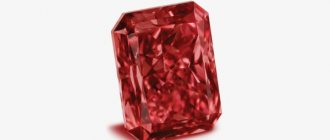A short excursion into the properties of rocks
Until the 17th century, no one suspected the similarities between coal, diamond and graphite. They never coexisted in nature. Moreover, scientists could not imagine the transformation of one substance into another. Everything changed when the English chemist Tennant conducted his experiment and found out their true nature.
Visually, it was not possible to understand this, since the breeds are completely different. Graphite does not have strong bonds and consists of flakes sliding over each other. Its main application is as a lubricant to reduce friction between surfaces. Externally, it looks like molten metal.
The coal composition includes small particles of graphite, but is supplemented with a hydrocarbon compound, oxygen and nitrogen, which gives it a denser rather than liquid-viscous form. Diamonds, in general, have one of the strongest compounds in nature. Externally, these are transparent stones, completely different from their “brothers”.
Diamond shine economy class
Much cheaper is the product of scientists from the Physical Institute of the USSR Academy of Sciences (FIAN), which they learned to make in 1970 by “thickening” zirconium dioxide. Its refraction differs little from that of a diamond; it is impossible to distinguish them by eye. In our country, such a “diamond” is called fianite by the institute’s abbreviation, and abroad – zirconite. And then artificial moissanite made from silicon carbide appeared on the shelves of jewelry stores.
Natural moissanite is almost as hard as diamond, and after cutting, colorless moissanite is indistinguishable from diamonds by the play of reflected light. A non-specialist is not able to distinguish them, and not every jeweler will say this right away. The only trouble is that moissanite is extremely rare, and its largest natural crystals are millimeter-sized.
Chemists also synthesized it, back in 1906, two years after the first discovery of moissanite crystals by geologists. But they learned to “thicken” artificial moissanites large enough for jewelry and transparent from silicon carbide relatively recently. In a word, scientists have made sure that people are not left without diamond shine even in cases where there is no money for diamonds.
Games with rocks: transforming one substance into another
Once scientists discovered the similarities between diamond, coal and graphite, they set out to learn how to transform one substance into another. The first experiments were successful.
It turned out that when a “gem” is heated in a vacuum to 1800 degrees, it completely turns into graphite. The same effect is obtained if an electric current is passed through coal heated to 3500 degrees. Having achieved success with these transformations, scientists set out to make an artificial diamond, and were stuck for almost 100 years.
The experiment on how to make a diamond from coal was crowned with success only in 1880 and took place in 2 stages. First, graphite was obtained by electrolysis. Then, it was placed in a steel flask, closed at both ends and heated red-hot. Sometimes, the vessel could not withstand the pressure and exploded. But, if everything went smoothly, then when the pipe was opened, dark but super-strong crystals were found inside.
Features of Paper Gems
Paper gemstones have precise edges and shapes that are almost completely identical to the real thing. Of the entire group, the most beautiful and original is the diamond. There are many ways to make a diamond out of paper. In this case, various techniques can be used - ready-made templates, origami, appliqué.
Examples of paper crafts: beautiful diamonds
A diamond made from paper or cardboard can be an excellent decorative addition to many crafts. Volumetric paper diamonds look especially beautiful. Here are some examples of crafts with different edge shapes:
- This form of “precious stones” is relevant if you need to make a vertical garland to decorate a room or photo zone.
- A natural-shaped diamond after a jewelry cut, formed from colored cardboard, can be used as decorations and theatrical props.
- Several options for the shapes of paper stones that can imitate a diamond with different cuts. From such figures you can create horizontal garlands for room decoration or a New Year tree.
Each presented craft differs in its shape and manufacturing principle. You can think of a lot of areas of application for such products. Additionally, the manufacturing principle itself can appeal to any child, developing his spatial thinking and imagination.
A safe way to get rich is a godsend for experimenters
There are many “legends” about how to grow a diamond at home. Identifying an effective and, most importantly, safe method among them is a difficult task to solve. The option that will be discussed now is suitable for those who like to experiment, but you should not seriously expect to receive a precious stone.
Attention! The site administration is not responsible for the possible consequences of the experiment.
The operating instructions assume the preparation of the necessary components. These include:
- pencil;
- the wire;
- water or liquid nitrogen;
- high voltage source (welding machine).
To get an artificial diamond, remove the lead from the pencil. Can be purchased separately. Now, connect it to the wire and lower it into the container. The next step depends on what you are using. In the first option, you should fill the structure with water and freeze it. In the second option, freezing occurs using liquid nitrogen.
Once you get the temperature you want, connect the wires to a voltage source and apply current. It is believed that after passing a discharge through the lead, it is transformed into a diamond.
Preparing for sculpting
It is better to do modeling with children at a table with good lighting. The child can sit on his own chair or on the lap of an adult: in the first case, the child has more freedom of action, in the second, learning proceeds faster. There should be enough space on the table for auxiliary materials.
Note!
Plasticine dinosaur: TOP-170 photos of creative DIY modeling solutions. Methods for making a dinosaur + simple master class
- Plasticine machine: simple diagrams and non-standard ideas for crafts made from plasticine. Step-by-step instructions for making a machine with your own hands with photo reviews
- What can be molded from plasticine - a master class on creating crafts from plasticine with your own hands. Creative modeling ideas + photo examples of the best works
Before starting modeling, you can offer your child a specific topic - this will arouse interest. In a playful way, adults can show children how to make animals out of plasticine, for example.
Modeling animals from plasticine will require some additional materials in addition to the plasticine set itself:
- modeling board;
- plastic knife for cutting plasticine;
- blank sheets of paper;
- photos of animals made of plasticine;
- a bowl of water and a hand towel, wet wipes.
If a child is modeling for the first time, then before starting the “Animals from Plasticine” master class, you need to briefly explain and show the properties of plasticine, what you can do with it, give the child to hold pieces of bright material - this will immediately create a desire to sculpt something .
Animals made of plasticine for children who have never sculpted anything before, although exciting, are not the easiest activity. An adult must show what elements can be made: the plasticine needs to be crushed in your hands, rolled into a ball, stretched out like dough, twisted in a spiral, flattened into a pancake, connected several parts of different colors, separated again.
After this, you can show how to wash plasticine off your hands. If this is not done, the plasticine will stick, for example, to paper. Let the child try to do this on his own with a piece of blank paper.
Note!
- How to make slime - the best ways to make slime at home. Simple and quick recipes with a step-by-step master class for children (150 photos)
- Plasticine dog - TOP-180 photos of unusual ideas for creating crafts. Detailed master class on DIY modeling for children
- Clay products: basics of modeling, tips for beginners. Master class on making clay crafts + photo reviews
Home experiment: obtaining crystals from salt
It is impossible to obtain a diamond without laboratory conditions. But, you can grow beautiful salt crystals with your own hands. For the experiment you will need:
- aqueous distillate;
- salt;
- strong thread;
- food coloring (for beauty).
Take a container and fill it with water. Add salt until it stops dissolving. Cut the thread and attach a salt crystal to it. Place the structure in the liquid and wait a few days. If you add food coloring, the “pebbles” will turn out to be different shades.
Salt is not the only material suitable for such chemical transformations. You can use sugar or copper sulfate. Then the crystals “grow” slightly different, but the technique remains the same. Enjoy your experiments.
Financial side of the issue
Now let’s estimate how much diamond jewelry made from artificial diamonds will cost. Many people underestimate the importance of these stones, and yet their price is sometimes higher than their natural counterparts. There are several reasons:
- visually they are indistinguishable;
- they have no inclusions, which is called “pure water stone”;
- they are stronger because they do not have cracks;
- their color does not fade;
- they are less whimsical.
The cost of stones depends on their weight, quality of cut and creation method. The most common zirconium dioxide (the most famous name is cubic zirconia) costs only 1.5-6 dollars per carat. But the cost of moissanite ranges from 75 to 155 dollars.
Getting Large Crystals
Next, let's talk about how large diamonds are made at home. For the experiment, you will need the same salt (100 g), distillate (400 ml) and stylus (12 g). Take a glass and mix the dry ingredients. Now, carefully fill them with water, wait until they are completely dissolved and leave the container for 24 hours.
The tutorial for making faux diamonds starts with you draining the water from the glass (into another container, as you will need it later). At the bottom of the vessel, you will find the crystals obtained from the reaction. Choose the most correct and large one (seed), and put the rest in a container.
Growing large home diamonds is a long process that requires patience. But, as a result, you will get a beautiful multifaceted stone that can be used to create jewelry or decor.
Take a strong thread and secure it to a pencil or any stick. Attach a seed to the other end and lower it into the remaining solution. All you can do is wait. As water evaporates, it will grow on your crystal and make it larger. If other pebbles form on the thread during the process, it is better to remove them.
Areas of application and opportunities
About 80% of created diamonds are used in industry and other areas of human life. For example, the production of bearings, tips for drills. Small pebbles can be used to make diamond chips and powder, which are used to coat knives or grinding tools.
Synthetic diamond plays an important role in electronics. They are used to create needles and layers in microcircuits and counters to maintain thermal conductivity and resistance. And this is only an approximate market where high-quality artificial stones can be sold.
For the production of CVD diamonds, the most important role is played by high-tech areas. They are necessary to create mobile phones. They are used to produce laser beams used in medicine: they are used to treat many deadly diseases. Therefore, the role of synthetic stones is enormous.
Is it possible to make a diamond from coal?
Surprisingly, coal and diamond are very similar in nature. What happens to a diamond if you burn it, and what happens to coal? Will a diamond leave ashes? Despite its high hardness, diamond burns excellently at a temperature of 700 C. Like ordinary coal, diamond does not leave behind any ash; it disappears in a blue flame without a trace.
It must be said that the nature of diamond was discovered back in the 18th century, and before that no one even suspected that the sparkling pebble had something in common with ordinary black coal. These amazing assumptions were made experimentally, using the analysis of the refraction of turpentine, camphor and diamond. To many chemists of that time, all these experiments seemed wild, since it was believed that diamond could not burn or evaporate under the influence of high temperature.
In 1772, Lavoisier conducted experiments on heating various materials and published a scientific work “On the destruction of diamond, there was convincing evidence of diamond combustion. He proved that burning diamond and coal.
Not every European, or indeed any country in the world, can boast of large oil reserves. But hydrocarbon fuels in the form of gasoline or diesel fuel are actively used in all countries. At the same time, deposits of brown and hard coal are much more common, hence the idea of producing diesel fuel and gasoline from coal. In this article we will look at how this is done in production and whether something similar can be organized in a private household.
How is gasoline separated from coal?
It is worth noting that the processing of coal in order to obtain different types of motor fuel is not a myth at all. Moreover, there are two proven methods that were put into practice at the beginning of the last century.
In those days, Nazi Germany, striving to conquer all of Europe, provided its military equipment with fuel precisely in these ways, since it did not have its own oil deposits. At the same time, the countries had at their disposal.
Diamond and graphite
Diamond mining is undoubtedly a fairly profitable business that can support the economy of any country. But nevertheless, many entrepreneurs would probably like to reduce the costs of obtaining these precious stones and thereby further increase the income of the diamond mining industry. What if it is possible to produce diamonds synthetically from graphite?
To answer this question, it is necessary to understand the nature of two materials - diamond and graphite. Many people still remember from chemistry lessons that these two seemingly different materials consist entirely of carbon.
WHAT IS A SYNTHETIC DIAMOND
At the end of the 18th century, scientists discovered that diamond is a form of carbon. This marked the beginning of numerous attempts to recreate the gemstone from available materials such as coal or graphite.
How did artificial diamonds come about?
Since the 19th century, many famous physicists and chemists have announced the successful completion of experiments in growing diamonds. True, none of these statements have been documented.
Only in 1927, the Soviet physicist O. Leypunsky made a breakthrough by calculating the conditions necessary for the process. Further research and experiments were carried out in parallel in the USSR, USA and Switzerland.
HPHT and CVD
The first working installation for crystal synthesis was created and patented by the Swede Balthasar Platen. He learned his method from nature.
Platen recreated similar conditions: a cell with nickel, cobalt and iron was heated and pressed with a multi-ton press. In this case, metals acted as a catalyst, and presses simulated pressure of thousands of atmospheres.
This method is called HPHT (High Pressure High Temperature) - high pressure, high temperature. The method is imperfect, but simple and inexpensive. Today it is used for the mass production of industrial diamonds and diamond dust.
In the 60s of the 20th century, a more advanced method was invented: CVD (Chemical vapor deposition) - chemical vapor deposition. The essence of the technology is the crystallization of diamonds from hydrocarbon gas onto a substrate grown by the HPHT method. CVD allows for the creation of larger, purer crystals.
Nano diamonds
In addition to HPHT and CVD, there are other, more narrowly focused technologies:
- detonation synthesis of diamonds - high temperatures and pressures are obtained due to the detonation of graphite. As a result of the decomposition of carbon-containing substances, nanocrystals are formed;
- ultrasonic synthesis of nanodiamonds - allows you to synthesize microcrystals from a suspension of graphite in an organic liquid at normal pressure and room temperature.
Similarities and differences
For a long time, HPHT diamonds and CVD diamonds differed from natural ones in size - under artificial conditions it was impossible to grow a stone larger than a carat. But many companies continue to work to eliminate this shortcoming.
Today, stones with the following characteristics are grown under artificial conditions:
Artificial diamonds have differences from natural ones:
- “artificial” may have metal inclusions left over from production;
- on colored stones you can see growth sectors that appear due to accelerated crystallization processes;
- Natural and artificial crystals luminesce differently in UV rays.
These differences can only be seen with specialized equipment. Therefore, suppliers and sellers of artificial diamonds are required to indicate on the product tags information about the origin of the crystals.
Artificial diamond and imitation are different things
Today there are two groups of diamond analogues:
- artificially grown stones with natural structure and qualities (moissanite, cubic zirconia);
- stones called diamond substitutes for their strong shine - colorless sapphire, rutile, Swarovski crystals, polymers.
The second group is imitation, because their structure and properties are far from natural.
Moissanite
The highest quality, durable, expensive artificial diamond. Chemically it is silicon carbide or carborundum. Minimal intervention is required to match the appearance of a real diamond. The stone is indifferent to external aggressive influences and is free from defects such as roughness or black inclusions inherent in natural minerals. Brighter than diamond, it is more difficult to distinguish than cubic zirconia. However, strong glare irritates many and betrays its origin.
The beauty is emphasized by a frame made of white gold, platinum or silver. Unlike diamonds that complement an evening outfit, Moissanite is appropriate for any time of day.
cubic zirconia
The stone is available in many colors, degrees of purity, and brightness. Colorless is one of the most valuable. Cubic zirconia is heavier than a diamond of equal size. This characteristic serves as a marker in determining the origin of the crystal.
Doesn't shine as brightly as a diamond, but does reflect glare better.
However, it scratches easily, becomes cloudy, absorbs oils, and turns greenish-yellow in the sun. You need to remember this when wearing jewelry.
Nexus
The result of carbon combining with other components. It is highly durable, so it has a virtually eternal guarantee.
Rhinestones
The most famous “substitute” for a noble diamond, originally crystal. Today the raw materials are glass or acrylic polymers.
The name was received in honor of the Alsatian jeweler Georg Strass, who came up with the idea of applying metal powder as a substrate to glass. Now the coating is created by depositing metal, and rhinestones have been improved, acquiring the Swarovski brand.
They are produced by the Austrian concern of the same name and the Czech company Preciosa.
Girls' best friends
It must be said that there is a weak point in this theory. As mentioned above, diamonds burn. Of course, there is no pure oxygen in the mantle, but long-term exposure of diamonds to the hot mass should still lead to their destruction. It follows from this that the very special magma mentioned above rises to the surface very, very quickly. Geologists previously avoided this detail (it rises and rises, what can you do), so the exact reasons for this process were unclear.
As part of the new work, scientists used a special smelter to obtain a substance resembling magma from the depths of the earth. In particular, the melt contained a large number of carbonates - salts of carbonic acid. Scientists have suggested that during its life, such magma encounters magma with large amounts of pyroxenes (a group of minerals, often rock-forming, containing silicon). Because of this, the ability of the melt to dissolve various kinds of substances - for example, carbon dioxide - is reduced several times.
To test their hypothesis, the researchers added pyroxenes to the melt and waited. According to one of the scientists, Kelly Russell, he was shocked when in just 20 minutes the hot substance essentially turned into foam. From this, scientists concluded that such foam pockets may well form at a depth of about 150 kilometers.
Alternative names in science and common people
In the scientific world, synthetic diamonds are named after the technology involved in their production. There are HPHT diamonds, which means created under high pressure and temperature. And CDV diamonds stand for chemical vapor deposition. We will tell you about the technologies themselves further.
But artificial diamonds are not always its complete copy. There are such types as cubic zirconia, moissanite, rhinestone, ferroelectric, rutile, fabulite and cerussite. Zirconium dioxide is the most common “fake” and has nothing in common with a real diamond.
Ignorant people call an artificial diamond a cubic zirconia, which is a big mistake. Of course, it perfectly imitates diamond due to its strength and refraction. Some experts cannot “by eye” distinguish it from the original stone. Therefore, they are widely used in the jewelry industry.
Auguste Verneuil method
At the end of the 18th - beginning of the 19th centuries, a scientist from France, Auguste Verneuil, developed a new method for producing artificial rubies, also called “melting in a flame.” This method marked the beginning of the stage of industrial synthesis of precious stones. They began to be used not only in jewelry, but also in the production of watches, measuring instruments and for other technical purposes.
Verneuil designed and tested a structure consisting of an oxygen-hydrogen torch, a powder dispenser from which the gem would be synthesized, and a ceramic base. In such an oven, a crystal 40–50 mm long can be grown in 3–4 hours. Depending on the chemical composition of the powder, stones of various colors are obtained, as well as their star-shaped varieties.
However, it will not be possible to grow a diamond at home using this technique; as a rule, corundums (rubies and sapphires) and spinel are synthesized this way. The Verneuil device produces synthetic titanite strontium and rutile, which can compete with diamonds in brilliance, but are less hard. High-quality imitation diamonds are also garnetites, lithium niobate and cubic zirconia.
